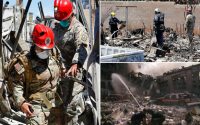Cardboard drones eyed in strikes on Russian airfields
Small flat-packed cardboard drones reportedly destroyed at least five Russian fighter jets in the western city of Kursk last weekend — and may also have been used in a devastating attack on a military airfield in Pskov Tuesday that took four transport planes out of commission.
The Sunday attack on the Kursk Airfield, located not far from the border with Ukraine, wiped out a Mig-29 and four Su-30 combat jets, Ukraine’s Security Service reported.
Two Pantsir missile launchers and the radar of an S-300 air defense system were also believed to have been damaged.
The strike nearly 100 miles into the Russian territory was said to have been carried out using innovative cardboard drones made by the Australian firm SYPAQ, which cost just $3,500 apiece and are virtually undetectable by Russian radar systems.
In March, the manufacturer announced it had secured a contract with the Australian government to deliver 100 of the drones each month to Ukraine.

The easy-to-assemble unmanned aerial vehicles — with a payload of 6.6 pounds and a range of up to 75 miles — were originally designed to deliver light orders from Amazon across vast distances in Australia.
In the Ukrainians’ hands, it appears that they have been transformed into kamikaze drones.
Although Ukraine has not officially confirmed the use of the SYPAQ drones, its Ambassador to Australia Vasyl Myroshnychenko wrote on X, formerly known as Twitter: “Cardboard drones from Australia used in attack on Russian airfield.”



A Ukrainian security service officer said that 16 drones had been launched at the target in Kursk and three were shot down.
Russia’s Defense Ministry confirmed the attack on the airfield but did not comment on any damage to the aircraft.
The Australian-made drones also may have been used in the more recent attack on the “Kresty” air base in Peskov — a picturesque medieval city that lies about 500 miles from the Ukrainian border in northwestern Russia near Estonia.


The operation was launched from within Russia, said Kyrylo Budanov, head of the Ukrainian Defense Intelligence.
“We work from the territory of Russia,” he told the online outlet The War Zone. He did not specify the number or type of drones used, and he also kept mum about who carried out the strike — employees of the Defense Intelligence of Ukraine, or “partisans.”
Budanov did confirm that four Russian IL-76 military transport aircraft were struck — as seen in satellite photos and videos that were published online, documenting the destruction of the aircraft.
“Two were destroyed and two were seriously damaged,” the military intelligence chief said.
The quartet of IL-76s were targeted specifically because Russia used them to airlift military cargo and troops, according to Budanov.

Witnesses reported seeing some 20 drones in the skies over Pskov, according to the Telegram channel Mash, followed by loud explosions that were said to have sparked a raging inferno at the air base.
When asked about the incident in Pskov, Kremlin spokesman Dmitry Peskov directed all questions to the Defense Ministry.
Ukrainian President Volodymyr Zelensky on Thursday praised what he said was the use of new Ukrainian weaponry with a range of 500 miles — about the distance from Ukraine’s border to Pskov.
Mykhailo Podolyak, a senior adviser to the president, warned on Friday that drone strikes on Russian soil will only escalate, indicating that the conflict was slowly shifting to Russia.

“As for Russia … there is an increasing number of attacks by unidentified drones launched from the territory of the Russian Federation, and the number of these attacks will increase,” Podolyak told Reuters.
“Because this is the stage of the war… when hostilities are gradually being transferred to the territory of the Russian Federation,” he added.
With Post wires


